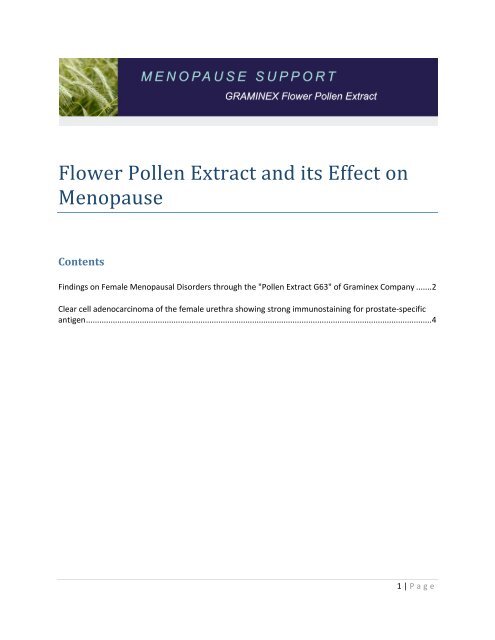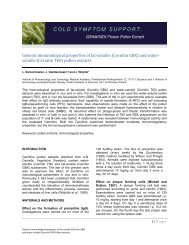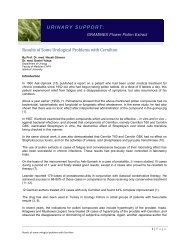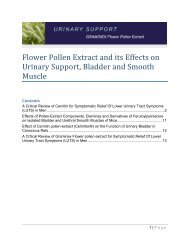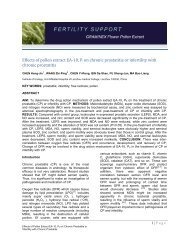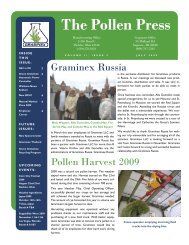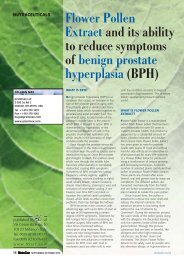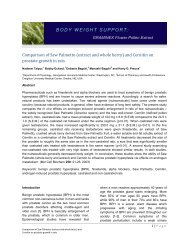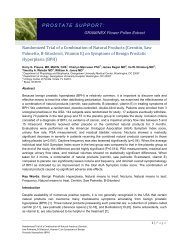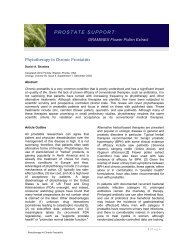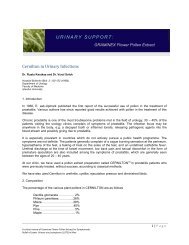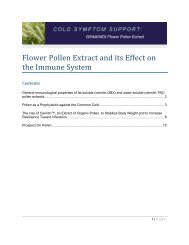Flower Pollen Extract and its Effect on Menopause - Graminex
Flower Pollen Extract and its Effect on Menopause - Graminex
Flower Pollen Extract and its Effect on Menopause - Graminex
You also want an ePaper? Increase the reach of your titles
YUMPU automatically turns print PDFs into web optimized ePapers that Google loves.
<str<strong>on</strong>g>Flower</str<strong>on</strong>g> <str<strong>on</strong>g>Pollen</str<strong>on</strong>g> <str<strong>on</strong>g>Extract</str<strong>on</strong>g> <str<strong>on</strong>g>and</str<strong>on</strong>g> <str<strong>on</strong>g>its</str<strong>on</strong>g> <str<strong>on</strong>g>Effect</str<strong>on</strong>g> <strong>on</strong><strong>Menopause</strong>C<strong>on</strong>tentsFindings <strong>on</strong> Female Menopausal Disorders through the "<str<strong>on</strong>g>Pollen</str<strong>on</strong>g> <str<strong>on</strong>g>Extract</str<strong>on</strong>g> G63" of <strong>Graminex</strong> Company .......2Clear cell adenocarcinoma of the female urethra showing str<strong>on</strong>g immunostaining for prostate‐specificantigen..........................................................................................................................................................41 | P a g e
Findings <strong>on</strong> Female Menopausal Disorders through the "<str<strong>on</strong>g>Pollen</str<strong>on</strong>g> <str<strong>on</strong>g>Extract</str<strong>on</strong>g>G63" of <strong>Graminex</strong> CompanyHiromi Yokoyama Naofumi Suzuki Yoshimi Nishimura(K<str<strong>on</strong>g>and</str<strong>on</strong>g>a New Medical Clinic)Female Menopausal Disorders occur at the <strong>on</strong>set of menopause, have as a characteristic ofindeterminate complaints, interference even occurs with intercourse, <str<strong>on</strong>g>and</str<strong>on</strong>g> becomes a source ofdiscord in partner relati<strong>on</strong>ships. A reducti<strong>on</strong> of female horm<strong>on</strong>es has been talked about as thecause. Here, we have examined the influence of pollen extract G63 <strong>on</strong> horm<strong>on</strong>es <str<strong>on</strong>g>and</str<strong>on</strong>g>improvement of the associated indeterminate complaints.[Objective <str<strong>on</strong>g>and</str<strong>on</strong>g> Methods]Six females, four in menopause <str<strong>on</strong>g>and</str<strong>on</strong>g> two evidencing menopausal symptoms having menstrual periodevery 4~5 m<strong>on</strong>ths, were studied for degree of improvement according to two horm<strong>on</strong>es Estradiol <str<strong>on</strong>g>and</str<strong>on</strong>g>DHEAS <str<strong>on</strong>g>and</str<strong>on</strong>g> the c<strong>on</strong>sultati<strong>on</strong> questi<strong>on</strong>naire. The period of the trial was from 1 to 3 m<strong>on</strong>ths. The pollenextract used in the trial was produced by <strong>Graminex</strong> Company in Ohio, USA from the pollen of rawmaterials such as rye, corn, <str<strong>on</strong>g>and</str<strong>on</strong>g> timothy hay (referred to as Phleum pratense in Japan) which werecultivated without using agrochemicals or genetically modified varieties. The pollen which has a doublehull is not digested or absorbed even when ingested since it has str<strong>on</strong>g resistance to acid <str<strong>on</strong>g>and</str<strong>on</strong>g> heat(cannot be destroyed even at 300°C). <strong>Graminex</strong> Company using a special technology is able toseparately extract G60 (water soluble nutriti<strong>on</strong> comp<strong>on</strong>ents) <str<strong>on</strong>g>and</str<strong>on</strong>g> GFX (lipid soluble comp<strong>on</strong>ents) <str<strong>on</strong>g>and</str<strong>on</strong>g> wereceived the product G63 which is a 20:1 combinati<strong>on</strong> G60 <str<strong>on</strong>g>and</str<strong>on</strong>g> GFX.The dosage was 6 tablets per day; three tablets each taken after breakfast <str<strong>on</strong>g>and</str<strong>on</strong>g> dinner. One 250 mg tabletc<strong>on</strong>tains 62.5 mg of pollen extract.(The daily quantity .... 375mg as pollen extract)Our own medical questi<strong>on</strong>naire was prepared <str<strong>on</strong>g>and</str<strong>on</strong>g> the number of points evaluated. (Lower points indicatemilder symptoms)No Symptoms N<strong>on</strong>e Slightly Medium HighPresent intensity intensity1 Heat sensitivity (burning 0 1 2 3sensati<strong>on</strong>, hot flashes)2 Chilling, numbness, edema of 0 1 2 3h<str<strong>on</strong>g>and</str<strong>on</strong>g>s or feet3 Perspirati<strong>on</strong> 0 1 2 34 Tachycardia (rapid heart 0 1 2 3beat)5 Palpitati<strong>on</strong> 0 1 2 36 Chest pains <str<strong>on</strong>g>and</str<strong>on</strong>g> 0 1 2 3breathlessness7 Headaches 0 1 2 38 Feel heavy-headed 0 1 2 39 Insomnia 0 1 2 32 | P a g eFindings <strong>on</strong> Femaile Menopausal Disorders through the<str<strong>on</strong>g>Pollen</str<strong>on</strong>g> <str<strong>on</strong>g>Extract</str<strong>on</strong>g> G63 of <strong>Graminex</strong> Company
10 Depressi<strong>on</strong> 0 1 2 311 Irritability 0 1 2 312 Feeling of anxiety 0 1 2 313 Dizziness 0 1 2 314 Feel dizzy up<strong>on</strong> st<str<strong>on</strong>g>and</str<strong>on</strong>g>ing up 0 1 2 315 Tinnitus (ringing in ears) 0 1 2 316 Stiff shoulders 0 1 2 317 Arthralgia in h<str<strong>on</strong>g>and</str<strong>on</strong>g>s <str<strong>on</strong>g>and</str<strong>on</strong>g> feet 0 1 2 318 Lumbago 0 1 2 319 Numbness 0 1 2 320 Sensati<strong>on</strong> like ants crawling 0 1 2 3<strong>on</strong> the skin[Results]<strong>Graminex</strong> <str<strong>on</strong>g>Pollen</str<strong>on</strong>g> Therapy Trials ... Female Menopausal DisorderName Age Examinati<strong>on</strong> Estradiol DHEAS C<strong>on</strong>sultati<strong>on</strong>Dayquesti<strong>on</strong>naireO_ T 48 Before Less than 10 65 17Administrati<strong>on</strong>Less than 10After 2 Less than 10 83 21m<strong>on</strong>thsY_ T 53 Before Less than 10 72 13Administrati<strong>on</strong>After 1 m<strong>on</strong>th Less than 10 89 6S_ M 54 Before 14 142 3Administrati<strong>on</strong>After 1 m<strong>on</strong>th Less than 10 112 4F_ N 50 June 21, 2005 27 106 420 79 2N_ A 63 June 21, 2005 Less than 10 121 5Less than 10 123 2K_ H 48 June 22, 2005 24 65 15Less than 10 74 10[C<strong>on</strong>clusi<strong>on</strong>] The increase in Estradiol was 0 for all subjects. DHEAS increased in 4 out of the 6 subjects<str<strong>on</strong>g>and</str<strong>on</strong>g> the average was 14.2%. Indeterminate complaints improved in 4 of the 6 subjects for a 54.1% degreeof improvement.[Discussi<strong>on</strong>] It can be c<strong>on</strong>sidered that the improvement observed in indeterminate complaints was dueto the amino acids, vitamins, <str<strong>on</strong>g>and</str<strong>on</strong>g> mineral comp<strong>on</strong>ents of the pollen extract which in the body assisted thepromoti<strong>on</strong> of metabolism. Additi<strong>on</strong>ally, there is evidence of rejuvenati<strong>on</strong> with secreti<strong>on</strong> of DHEAS whichnormally peaks for pers<strong>on</strong>s in their twenties. Moreover, the DHEAS value is also used as an indicator offemale sexual desire <str<strong>on</strong>g>and</str<strong>on</strong>g> it can be c<strong>on</strong>sidered that sexual appetite was also increased <str<strong>on</strong>g>and</str<strong>on</strong>g> it can beassumed that increased DHEAS helps to remove interference to intercourse for menopausal females.[Safety] Am<strong>on</strong>g the findings, in particular there were no side-effects <str<strong>on</strong>g>and</str<strong>on</strong>g> the supplement can beadministered with peace of mind.8/23/20053 | P a g eFindings <strong>on</strong> Femaile Menopausal Disorders through the<str<strong>on</strong>g>Pollen</str<strong>on</strong>g> <str<strong>on</strong>g>Extract</str<strong>on</strong>g> G63 of <strong>Graminex</strong> Company
Clear cell adenocarcinoma of the female urethra showing str<strong>on</strong>gimmunostaining for prostatespecific antigenK. KAWANO, M. YANO, S. KITAHARA <str<strong>on</strong>g>and</str<strong>on</strong>g> K. YASUDADepartment of Urology, Dokkyo University School of Medicine, Koshigaya Hospital, Saitama, JapanCase reportA 49‐year‐old woman presented with the chiefcomplaint of voiding difficulty. On digital vaginalexaminati<strong>on</strong>, a walnut‐sized mass was c<strong>on</strong>®rmedaround the urethra. Abdominal ultras<strong>on</strong>ographyshowed a mass at the bladder neck (Fig. 1), <str<strong>on</strong>g>and</str<strong>on</strong>g>cystoscopy revealed the tumour protruding from theposterior urethral wall at the bladder neck.Subsequent b<strong>on</strong>e scintigraphy, systematic CT <str<strong>on</strong>g>and</str<strong>on</strong>g>serum chemistry showed no metastasis. The patientunderwent transurethral biopsy of the tumour, <str<strong>on</strong>g>and</str<strong>on</strong>g>the histological diagnosis was carcinoma composedof high‐grade cancer cells. Under the diagnosis of aninvasive but localized urethral tumour, totalcystourethrectomy was performed, includinganterior vaginal wall <str<strong>on</strong>g>and</str<strong>on</strong>g> pelvic lymph nodedissecti<strong>on</strong>. An ileal c<strong>on</strong>duit was chosen for urinarydiversi<strong>on</strong>. The anterior vaginal wall was intact, butthe tumour invaded the mucosa <str<strong>on</strong>g>and</str<strong>on</strong>g> muscle layer ofthe bladder trig<strong>on</strong>e. No lymph node metastasis wasdetected. The patient was free of disease a year aftersurgery. Microscopy of the tumour showed clear‐celltype adenocarcinoma, most of which c<strong>on</strong>tainedclearly vacuolated cytoplasm <str<strong>on</strong>g>and</str<strong>on</strong>g> pleomorphic nuclei(Fig. 2a). The histological diagnosis was mes<strong>on</strong>ephricadenocarcinoma. Immunohistochemical staining,using the two‐step indirect immunoperoxidasetechnique with antibodies to PSA (L‐1838, Dako,Glostrup, Denmark), showed str<strong>on</strong>g cytoplasmicreacti<strong>on</strong> in the tumour cells (Fig. 2b). Serum PSAlevels were not measured before surgery, but at thefollow‐up serum PSA levels were estimated severaltimes (T<str<strong>on</strong>g>and</str<strong>on</strong>g>em‐R, Hybritech, San Diego, CA, USA); allwere below the detectable limit (
the female clear cell adenocarcinoma arises from thepara‐urethral duct, as the present case was alsopositive immunohistochemically for PSA. However,there are variable terms for the neoplasm, e.g.mes<strong>on</strong>ephroma, adenocarcinoma of Skene's paraurethralgl<str<strong>on</strong>g>and</str<strong>on</strong>g>s, <str<strong>on</strong>g>and</str<strong>on</strong>g> tumour of theFig. 2. a, Secti<strong>on</strong>s of the tumour showing clear cell type adenocarcinoma (haematoxylin <str<strong>on</strong>g>and</str<strong>on</strong>g> eosin r400) <str<strong>on</strong>g>and</str<strong>on</strong>g> b, immunohistochemicalstaining for PSA showing a str<strong>on</strong>g cytoplasmic reacti<strong>on</strong> in the tumour (r600).female para‐urethral duct. Therefore, the use of amore unified nomenclature is desirable. Clear celladenocarcinoma of the female urethra is acomparatively rare entity; there are 42 cases of thisneoplasm reported, including the present case, fiveof which had positive immunohistochemical stainingfor PSA. Only <strong>on</strong>e was negative, but microscopyshowed this tumour to be truly of para‐urethral ductorigin [5].CLEAR CELL ADENOCARCINOMA 413References1. Peven DR, Hidvegi DF. Clear‐cell adenocarcinoma of thefemale urethra. Acta Cytol 1985; 29: 142±62. <str<strong>on</strong>g>Pollen</str<strong>on</strong>g> JJ, Dreilinger A. Immunohistochemicalidenti®cati<strong>on</strong> of prostatic acid phosphatase <str<strong>on</strong>g>and</str<strong>on</strong>g> prostatespeci®cantigen infemale periurethral gl<str<strong>on</strong>g>and</str<strong>on</strong>g>s. Urology 1984; 23: 303±43. Spencer JR, Broden AG, Ignatoff JM. Clear celladenocarcinoma of the urethra: evidence for origin withinparaurethral ducts. J Urol 1990; 143: 122±54. Zaviacic M, Sidlo J, Borovsky M. Prostate speci®c antigen<str<strong>on</strong>g>and</str<strong>on</strong>g> prostate speci®c acid phosphatase in adenocarcinomaof Skene's paraurethral gl<str<strong>on</strong>g>and</str<strong>on</strong>g>s <str<strong>on</strong>g>and</str<strong>on</strong>g> ducts. Virchows Arch APathol Anat Histopathol 1993; 423: 503±55. Kamoto T, Noguchi T, Okabe T, Takai I, Matsumoto M. Acase of clear cell adenocarcinoma of the female urethra.Acta Urol Jpn 1993; 39: 965±6AuthorsK. Kawano, MD, Urologist.M. Yano, MD, Urologist.S. Kitahara, MD, PhD, Associate Professor.K. Yasuda, MD, PhD, Professor.Corresp<strong>on</strong>dence: Department of Urology, DokkyoUniversity School of Medicine, Koshigaya Hospital, Saitama,Japan.# 2001 BJU Internati<strong>on</strong>al 87, 412±4135 | P a g eClear Cell Adenocarcinoma of the Femail Urethra showing Str<strong>on</strong>gImmunostaining for prostate-specific antigen


